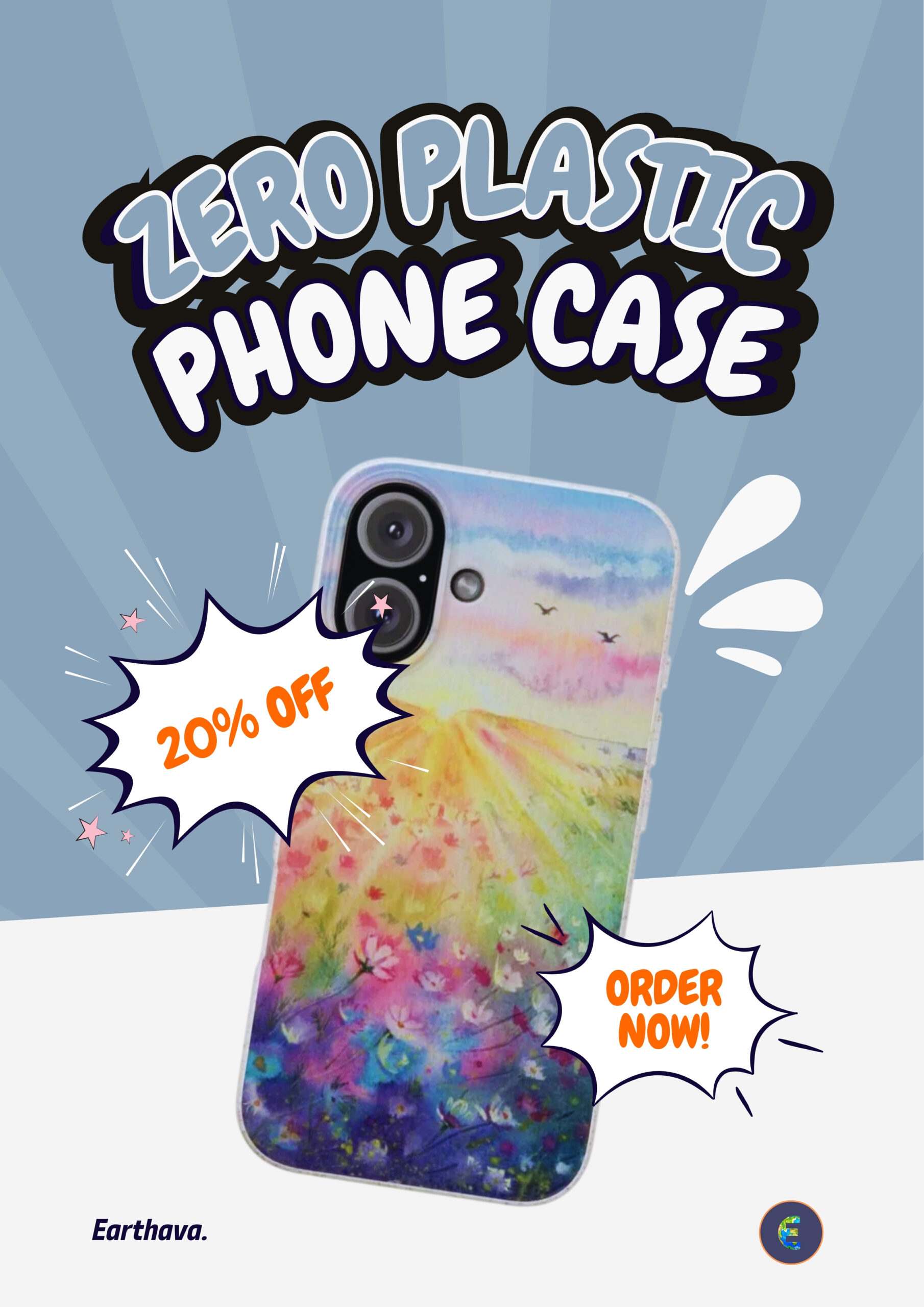Reusable menstrual pads are a type of menstrual hygiene product and are an alternative to disposable sanitary napkins or menstrual cups. Because they can be reused, they are often more cost-effective than disposable sanitary napkins. In addition, they are often made from more environmentally friendly materials than disposable sanitary napkins and can be worn during more physical activity[1].
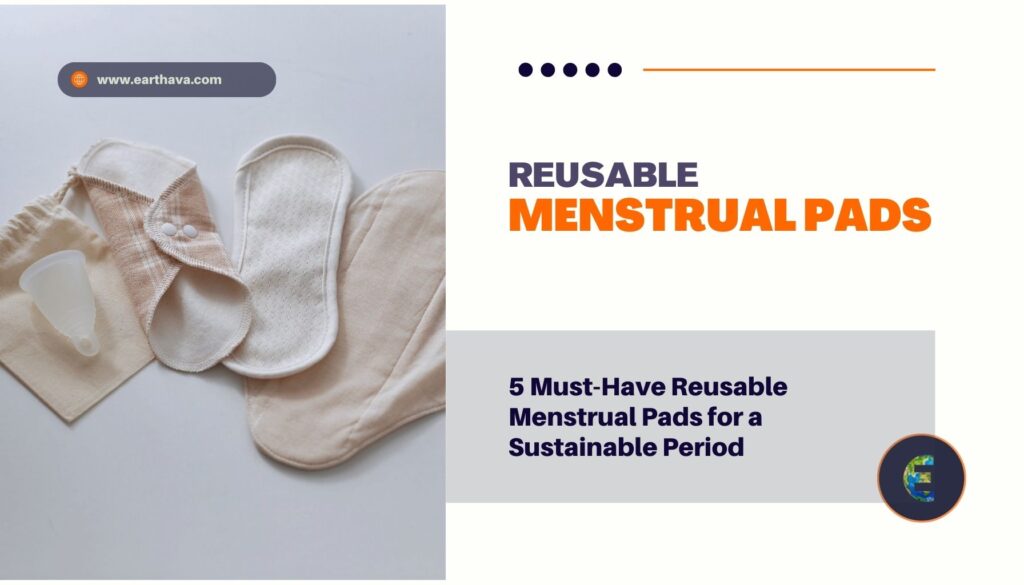
Winner
🥇wegreeco Bamboo Reusable Sanitary Pads
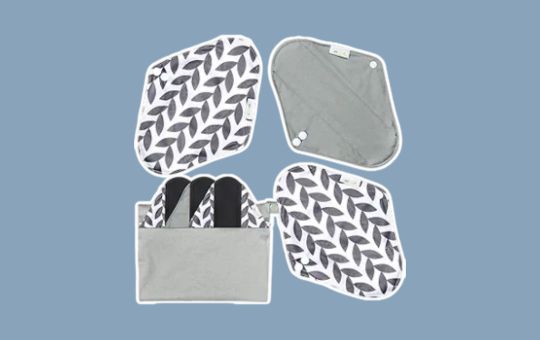
Summary
Wegreeco Bamboo Reusable Pads emerge as the best choice in your set because they strike a strong balance: softness, reasonable absorbency, stability, clean design, and value.
What are the Best Cloth Pads?
These days, it’s easy to find a wide range of menstrual products. Thanks to the recent interest in natural, healthy, and eco-friendly alternatives to disposable products, you can now buy reusable cloth pads, menstrual cups, and even period underwear. While reusable products are often more expensive than disposable ones, they’re much cheaper in the long run.
1. Leekalos: Bamboo Menstrual Cloth Pads (6 Sets)
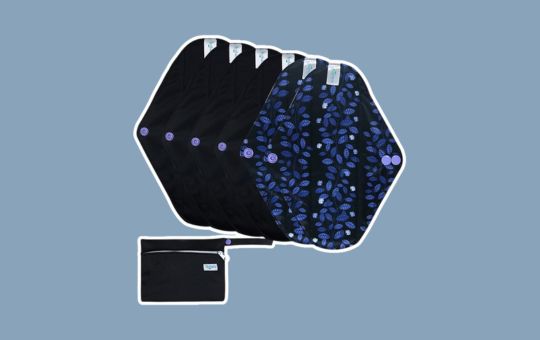
When you pull this pack together, you’ll see six bamboo-charcoal pads in your choice of size (small, medium, or large), plus a mini wet bag that, honestly, feels like they thought of the little things right. Showing up with style and the basics covered sounds like a good day.
Specs & features, from what we’ve parsed out:
Product listings tell us these pads use a leak-free outer layer, all the better for keeping things confident, and then a bamboo-rich fabric against your skin paired with up to 5 absorptive layers, depending on size. The snap-on wings help them stay anchored. The size chart reads: small ~7.4×7 in, medium ~9.2×7.2 in, large ~10.6×7.2 in. And, yes, the included wet bag gives you a quick, discreet carry option. Machine-washable, cold wash recommended, then air-dry, that seems to be the safe play.
What truly stands out, what maybe makes you pause
BVR, that review aggregator, gives these pads a 9.6 out of 10 overall across comfort, absorbency, value, you name it. That kind of score doesn’t happen unless it’s doing something right. But. There’s a note buried in there: “May not be ideal for sensitive skin.” It’s brief, but honest. Worth acknowledging.
What users are actually saying
- BestViewsReviews highlights the leak-free layer being a real superhero, “can hold heavy flow for hours,” plus, “two snaps keep it in place.” That’s solid autonomy.
- Other retailers talk up how soft it feels, like swapping underwear, easy to keep clean and pack, and that bamboo just feels nicer.
- A subtle but telling worry: some users say the pads “slide back” on underwear, and that could cause leaks or stains. A small detail, but one we can’t ignore.
- On Reddit, though not Leekalos-specific, bamboo layers are praised for being thin-but-layered: “it feels like a very thin (but layered) cloth pad” if that context helps.
Who might find these align with their flow and values
- If you like things soft, eco-friendly, and absorbent, these tick a lot of boxes.
- If you need size variety (small through large) in one design line, that’s here.
- If you’re moving away from disposables and want something reliable for moderate to even heavier days.
- If you do care about fit, maybe know your underwear’s shape well, and aren’t squeamish about snap placement, or have sensitive skin (testing first might be smart).
✅ Pros
- Exceptional comfort and absorbency, trusted and backed by a 9.6 BVR score.
- Leak-resistant outer and secure snap design give confidence that you can actually move around.
- The bamboo-charcoal layer is breathable, eco-friendly, and just feels nicer against your skin.
- Comes with a discreet wet bag, which makes packing and commuting life smoother.
⚠️ Cons
- A few users said the pads shifted and caused embarrassing leakage.
- Not all skins love the material; some claim mild irritation.
- Honest, heavy-flow testing seems more inferred from ratings than spelled out. You might need to change more often at night.
Earthava’s Take
Leekalos feels like someone designed with genuine care, not marketing flash. Bamboo comfort, a wet bag that makes sense, sizes for different days, it’s thoughtful. The fit issue is worth noting, but not deal-breaking for most. If you’re building a reliable reusable kit, from moderate flow to overnight security, this set feels solid. Maybe pair with a backup if you go heavy and love your PJs tight.
2. Teamoy: Reusable Washable Cloth Menstrual Pads (10 Sets)
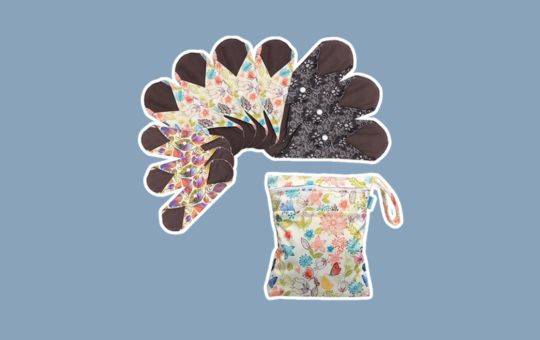
When you pick up this set from Teamoy, you’re really getting the whole kit, ten pads in three different sizes (small, medium, and a long overnight length) plus a wet bag that doesn’t feel like an afterthought. It’s clearly designed for people who don’t want to be locked into one size for their whole cycle.
The pads are built from layers: a soft charcoal polyester top, microfiber for the absorbency, and a leak-resistant bottom. Snap-on wings keep them anchored to your underwear, and when you’re done, you can fold them into a little bundle that looks more like a handkerchief than a pad. Handy if you’re out and about.
What truly stands out, what maybe makes you pause
Honestly, the wet bag is the star here. It has two compartments, clean and used, which sounds like a small thing but makes life easier when you’re juggling pads on a busy day. Plenty of users mentioned it in reviews, sometimes more than the pads themselves.
On the flip side, these aren’t thin. Several buyers flat-out called them bulky. The charcoal and microfiber layers do absorb well, but they create thickness. If you’re wearing tighter jeans or want a slim profile, that’s the trade-off.
What users are actually saying
- Comfort comes up again and again. People describe them as soft and breathable, with no leaks if you change them in a reasonable time.
- Cleaning isn’t a nightmare. Charcoal fabric helps with staining, and most reviewers said washing it was straightforward.
- But yes, bulk. Some call them “like wearing a mini diaper.” Others don’t mind, especially at night.
- A few sensitive-skin users mention preferring cotton or bamboo pads instead, since polyester can irritate.
Who might find these align with their flow and values
- You want one purchase to cover light, medium, and heavy days without mixing brands.
- You like having a secure wet bag setup (for school, work, or travel).
- You prioritize absorbency and reliability over a barely-there feel.
- You’re okay with synthetics. If your skin is sensitive, you might look at organic cotton brands instead.
✅ Pros
- Variety of sizes in one set.
- A wet bag with two compartments is genuinely practical.
- Comfortable and leak-resistant.
- Easy to wash, charcoal helps hide stains.
⚠️ Cons
- Thicker than some competitors.
- The synthetic top layer is not ideal for sensitive skin.
- Takes time to air dry after washing.
Earthava’s take
Teamoy pads come across as practical, not glamorous. They’ll give you coverage, they’ll save money over time, and that wet bag design is better than most. The main compromise is bulkiness; you notice them when you wear them. Some people won’t care, especially overnight. Others might rotate them with slimmer pads for daytime.
3. wegreeco: Bamboo Reusable Sanitary Pads

When you open the box, you find six medium-sized cloth pads, each with a bamboo-charcoal lining and a microfiber layer, and a mini wet bag that feels thoughtfully designed. It’s that kind of pack that looks like someone actually thought, “Okay, you might need a reliable mid-flow option, and a way to carry it.”
A closer look at the details
According to Wegreeco’s product description, each pad uses a leak-free laminated outer shell, bamboo charcoal against your skin, and microfiber absorbency in the middle. The wings snap around your underwear snugly, and they are two snaps, flexible enough for a decent fit. And the mini wet bag, leak-proof and compact, makes carrying both clean and used pads easier than fumbling with plastic bags.
What stands out, and what gives pause
Honestly, that wet bag keeps popping into user mentions. A Reddit user in r/ZeroWaste said it’s one of the reasons they remember the brand, “comes with a nice carrying bag for on the go”. That’s gotta count for something.
On the other hand, there’s a bit of a jackpot highlight from r/moderatelygranolamoms: some folks highly recommend them for postpartum or heavy flow, one user said, “hold up like a champ during the heavy days.” But if we’re being honest, it hints at their capacity, but also makes you wonder if they’re a bit bulky for everyday wear.
What users are really saying
- Comfort and durability: One Amazon-style review says they’re comfortable and breathable, “zero-feel experience” was how it was pitched. Another review praises their cottony comfort and how well they stay put and absorb odors.
- Postpartum and heavy flow: The Reddit recommendation mentioned above isn’t praise for light flow; they’re being trusted during the heavy days.
- No major complaints: Most chatter is positive; you don’t see a ton of irritation or loose wings. Someone in r/ZeroWaste called them “pretty good… very absorbent and no smell”, even after lots of use.
Who might find this set a good match?
- If you want solid absorption and reliable coverage, especially for medium or postpartum flow, this could serve well.
- You’re curious about cloth pads but want simplicity, no mixing brands, just one comfy pack that handles most flow days.
- That wet bag matters. If you carry pads to work, school, or just your bag, the convenience factor is real.
- If you prefer thinner, barely-there liners, these might feel a bit thick.
✅ Pros
- The bamboo charcoal layer feels soft, smells neutral, and helps with stains.
- Leak-proof laminated outer layer inspires confidence.
- Dual snap design holds well without shifting.
- Mini wet bag is genuinely useful for discreet transport, cheers from real users on Reddit.
- Users trust it for heavy flow or postpartum, and it does hold up under pressure.
⚠️ Cons
- Medium size only, so if your flow patterns vary, you might supplement with other sizes.
- Slight bulkiness might be noticeable under tighter clothing.
- Synthetic materials and laminates are nice for leaks, but maybe not for ultra-sensitive skin.
Earthava’s Take
Wegreeco’s 6-pack of medium, luxury cloth pads feels like a dependable player in your reusable pad lineup. Not ultra-sleek, but solid. That wet bag alone makes it feel more user-friendly than “here’s a pad, good luck.” Real users lean on them during heavy days and postpartum, and no one seems to have muttered “leaked on me, ”which in period gear conversation = gold.
4. Natissy: Ultra-Soft Organic Cotton Reusable Panty Liners
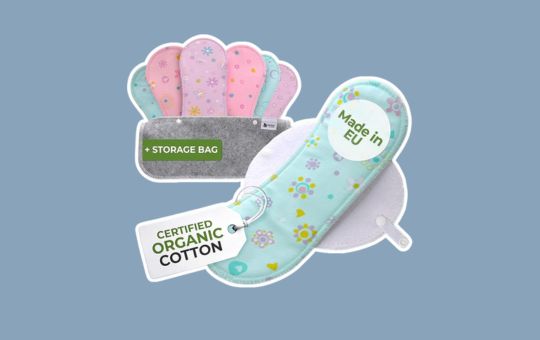
This set includes seven small-sized panty liners made in the EU, made predominantly from organic cotton, designed for things like daily vaginal discharge (or very light flow). It’s minimalist: just liners (wings included), no pads for heavy days, no wet bag. If you want something light, breathable, and that feels natural, this is the pick.
Specs & Features
- Upper layer: 95 % certified organic cotton, 5 % elastane. That gives a bit of stretch/support.
- Bottom layers: A combination of ~70 % cotton, ~30 % polyester, plus a certified polyurethane (PUL) membrane (without PVC or formaldehyde). That’s for leak protection.
- Wings: Yes, wings with a snap, to wrap under the underwear so the liner stays more secure.
- Made in the EU: Designed & manufactured in EU countries (Germany or nearby).
- Washability: High-temp washable, though specific temperature guidelines are on their site. Organic cotton tends to hold up better under harsher washes. Users note it washes and dries “wonderfully.”
- Thickness & feel: Described by users as soft, breathable, yet “thick enough to give protection” (for the liners’ intended light purpose). Not ultra-thin, but not bulky either.
What stands out, and what might be a downside
Standout feature: The use of organic cotton (certified), especially in the top layer. According to users, this translates into greater comfort, less irritation, and a more natural feel. For daily-use liners, that feels like a real win, especially if disposable liners have caused you itch or discomfort. Lots of praise for how “soft” they are.
Drawback: Because they’re meant for light discharge, they don’t offer much protection for anything heavier. If your flow creeps into light period territory, or you occasionally need something overnight, these won’t suffice. Also, the wings/snaps seem thinner in comparison; for some users, that could mean a less snug fit. A few reviews say the wings are “a bit soft,” which might reduce how firmly they stay in place, especially under movement.
What users are really saying
- From Natissy’s site: “Comfort, quality, soft… simply great.” One user says: “At last a product all of cotton, what my skin tolerates without any problem.”
- Another: “They stay in place, they are designed perfectly to be slim enough for everyday use; … you don’t notice them throughout the day.”
- Some say the finish is “impeccable,” that there are no leaks (for what they use them for), and that the designs/patterns don’t have unnecessary stuff like diagonal stitching that shows through underwear.
- On the flip side: because of the thinness and light protection, a few users note that if you move a lot (walking, exercising) or have heavier discharge, you might need to change more often than with thicker or more absorbent liners/pads. There are occasional minor complaints about wings feeling a little loose.
Who this is ideal for
- If your daily vaginal discharge is light, you want something breathable, soft, and natural against your skin.
- If you have sensitive skin and prefer organic materials.
- Those who mostly want to replace disposables for everyday liner usage, not for menstrual bleeding nights.
- Anyone who doesn’t need heavy absorption but wants good finishing, decent durability, and ease of washing.
If you need something for heavier flow, or want liners that double for period spotting or overnight backup, this isn’t the go-to by itself.
✅ Pros
- Organic cotton top layer gives softness and better skin friendliness.
- Breathable and comfortable, users mostly report that these liners feel good all day.
- Slim design with wings helps with staying put.
- Washes and dries well; good durability for daily use.
- Made in the EU, certified materials, fewer synthetic or harmful extras (no PVC/formaldehyde in membrane).
⚠️ Cons
- Limited absorbency, just for very light use/discharge. Doesn’t substitute for pads or heavier liners.
- Wings/snaps are a bit soft; may shift or feel less secure under active movement.
- Because natural fabric tends to shrink slightly or change shape if washed hot or dried roughly, you need to follow the washing care instructions. (Not many report shrinkage, but organic cotton tends toward that risk in general.)
- Cost per liner is steadier than disposables; initial investment is higher (but amortized over time).
Final Earthava’s Take
Natissy’s small 7-pack organic cotton liners strike a lovely balance for daily freshness: soft, breathable, well-finished. If your flow is light and consistency matters (you want something you can trust day in and day out), these feel like they deliver. They shine at replacing disposable liners without that synthetic stiffness, and people who use them tend to come back to them.
5. Langsprit: Absorbent Reusable Sanitary Pads
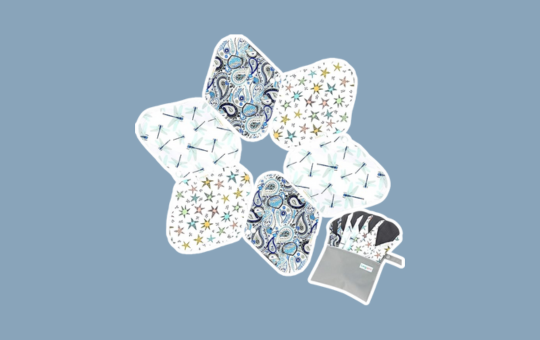
When you unwrap this kit, you get six medium-sized reusable pads (yes, just one size, Medium) and a mini wet bag. Feels like Langsprit thought: “Let’s give you a reliable all-month companion, and something neat to stash them in.”
Specs and feature notes
The product listings explain that each pad comes with a “no-leak” cloth outer, plus a bamboo-charcoal layer that makes contact with your skin. Two-snap wings help keep them anchored. They come in three lengths, small, medium, and large, but this pack sticks to medium only. Amazon and other listings promise they’re great for overnight or heavy-flow use, holding up for up to 10 hours.
What shines (and what raises an eyebrow)
The truth is, people often focus on that bamboo-charcoal fabric, not just soft, but odor-managing, which reviewers on sites like DesertCart appreciate (“Comfy and odourless!”). That’s decent reassurance when cloth pads worry you with a “will it smell?” question.
On the other hand, there’s a review from Walmart that warns that they shrink a lot after washing. That’s a real thing. “When they are washed, they shrink to VERY small. Won’t buy them again.” Ouch. That matters for sizing and fit.
Real-user chatter
Over at DesertCart, one user said they were pleasantly surprised:
“I am happy with the quality… Soft and snaps are strong… I cannot speak for how well they absorb but they seem well-made. … I was surprised how thin they were.”
Another comment:
“They do the job… moderate day, had no issues… no leaks.”
So, generally decent comfort and leak control, although not everyone added details about heavy-flow testing.
Who might find these align with their flow and values
- If you prefer medium-length pads for regular to heavier days and want something that feels soft against your skin, this is right in that zone.
- If odor management is a plus, the bamboo-charcoal layer delivers.
- If you don’t mind fussing over a little shrinkage (or washing with cold water/light dry), they might still work, but be cautious if you’re relying on the exact fit.
- If you need varied sizes or a slimmer fit, then maybe look elsewhere.
✅ Pros
- Soft, bamboo-charcoal layer, comforting and odor-resistant according to users.
- Snaps are strong; design is considered thoughtful and well-built.
- Hold up well on moderate flow; no leaks reported in several user accounts.
- Included a mini wet bag, a neat and practical addition.
⚠️ Cons
- Only “Medium” size in the set, no variation for lighter or heavier days.
- Shrinkage after washing reported (“VERY small”).
- Limited transparency on how absorbent they are over extended heavy-flow days, just “seems well made,” not tested claims.
Earthava’s take
Langsprit’s 7-piece set feels dependable. There’s a softness and odor-control vibe that readers consistently mention. And for moderate flow or everyday wear, they appear to hold up, no drama, no leaks. But that shrinkage flag is worth noting; if your fit is key, you might want to err on the side of caution or wash carefully.
Common FAQ
Navigating through eco-friendly products or sustainable living solutions often raises a few questions. To help you make informed decisions, we’ve compiled a list of frequently asked questions about reusable menstrual pads. From product details to usage tips, this section aims to address the most common concerns and provide clear, concise answers. Whether you’re new to this subject or looking for specific insights, our FAQ section is here to guide you.
Types
There are many different varieties of reusable sanitary pads, including washable, cloth menstrual pads, reusable menstrual panties, and reusable menstrual underwear[2].
What are they made from?
Reusable sanitary pads are usually made of an absorbent material that is sandwiched between two waterproof materials. These cloth menstrual pads are usually made in several layers that have cotton or hemp, but not plastic[3]. The outer layers are usually made from cotton or hemp because they effectively absorb blood. The top layer is the layer that is in touch with the skin. This layer is usually made from bamboo or organic cotton for softness[4]. The bottom layer is made from polyester or flannel, just to make sure it won’t leak.
When Were Reusable Menstrual Pads First Used?
No one is sure when reusable pads were first used, but there is evidence that shows women in Africa used pieces of cloth for that purpose. The cotton pads we use today are more like the ones used in Ancient Rome and were made from lint from the belly of sheep. The first reusable pads were just pieces of cloth and they were used so that women could avoid the smell and mess of the primitive sanitary napkins that consisted of cotton, wood, and pieces of paper.
It was not until the 20th century that pads became big business and even then, they were mostly used by women in the Middle East and Asia. Reusable pads are made of fabric, but they are quite different from the reusable pads that are used today.
A menstrual pad is a sanitary product worn by women during menstruation to protect their clothing from the menstrual fluid. It is also known as a sanitary towel, sanitary napkin, sanitary nappy, pad, panty liner, or lady’s napkin. Menstrual pads have been around for thousands of years but became commercially available and popular in the 20th century.
The first modern disposable menstrual pads appeared in the 1930s and were made from wood pulp and held together with Cellulose Acetate Adhesive. The first commercial pads, called “S Kotex”, were made with an outer wrapping of heavy crepe and an inner lining made of cotton wool. These were soon followed by pads using rayon and cotton flannel. The first commercial pads were sized and were advertised as being able to handle “8 days of normal flow”.
What Are The Pros of Using Reusable Menstrual Pads
Some reusable products like menstrual cups are free! By switching to reusable menstrual products, you’ll save money, reduce waste, and get the period products that work best for you. There are lots of reasons to consider reusable menstrual products instead of disposable ones. In addition to the obvious financial and environmental benefits, reusable menstrual products are often more comfortable, convenient, and easy to maintain than disposables.
The Advantages include:
• Environment-friendly: If you are using disposable pads, you are adding to the world’s waste problem. These pads often can’t be recycled, and they are just thrown into landfills.
• Save Money: You will save money by using reusable pads. Some women spend $300 a year on disposable pads. These pads often last for only one cycle.
• Convenient: You can use reusable pads when you are traveling or at work. It is also much more discreet than using tampons.
What Are The Cons of Using Reusable Menstrual Pads
The main disadvantage of using reusable menstrual pads is the need to wash them regularly. While disposable pads are already washed during the manufacturing process, reusable pads need to be washed in your own home. However, washing a reusable pad is not a difficult task. If you want to save money and reduce the amount of waste you produce, reusable pads may be a good option for you.
The Disadvantages include:
• Some women find them uncomfortable.
• You have to do laundry every week.
• They may not be as effective as disposable pads.
Conclusion
We hope you enjoyed this blog on reusable menstrual pads. Have you tried reusable pads? If so, please let us know what your experience has been like. Have you used other reusable menstrual hygiene products? If so, please share with us in the comments on our Facebook and Instagram pages. Thanks for reading, and happy periods!

